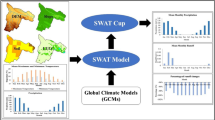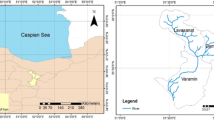Abstract
This study sets out to simulate various hydrological responses to climate change. The semi-distributed hydrologic model of the Soil and Water Assessment Tool, SWAT, was used to simulate different parts of the hydrological cycles. The comprehensive assessment of the effect of climate change on runoff, crop yield, and water balance in Siminehroud and Zarrinehroud watersheds is the novelty of this research. The simulation period was from 1988 to 2014. The runoff model was calibrated using the plant parameters, and the initial crop yield was used to calibrate the model. During the calibration and validation periods, the statistical measures, namely NS and R2, were obtained as 0.69 and 0.82, respectively. Using the multisite statistical downscaling of the LARS-WG climate model, we introduced the future climatic conditions as inputs to the model based on two optimistic (RCP2.6) and pessimistic (RCP8.5) scenarios. The most significant changes in the runoff in the upcoming period, was in June, reduced by 4.2 m3s−1, and in May, increased by 4.8 m3s−1 in the optimistic scenario. In the RCP8.5 pessimistic scenario, the most significant runoff change was observed in June and October. The results indicated that these changes would lead to a decrease in the main crops across the region.






Similar content being viewed by others
References
Aawar T, Khare D (2020) Assessment of climate change impacts on streamflow through hydrological model using SWAT model: a case study of Afghanistan. Modeling Earth Systems and Environment 6(3):1427–1437
Aboulnaga M, Mostafa M (2020) Climate change adaptation: Prioritising districts for urban green coverage to mitigate high temperatures and UHIE in developing countries. In: Renewable energy and sustainable buildings. Springer, Cham, pp 825–837
Ahmadzadeh H, Morid S, Delavar M, Srinivasan R (2016) Using the SWAT model to assess the impacts of changing irrigation from surface to pressurized systems on water productivity and water saving in the Zarrineh Rud catchment. Agric Water Manag 175:15–28
Amini A (2020) The role of climate parameters variation in the intensification of dust phenomenon. Nat Hazards 102(1):445–468. https://doi.org/10.1007/s11069-020-03933-w
Amini A, Ali TM, Ghazali AHB, Huat BK (2009) Adjustment of peak streamflows of a tropical river for urbanization. Am J Environ Sci 5(3):285–294. https://doi.org/10.3844/ajessp.2009.285.294
Amini A, Ghazvinei PT, Javan M, Saghafian B (2014) Evaluating the impacts of watershed management on runoff storage and peak flow in gav-darreh watershed, kurdistan, Iran. Arab J Geosci 7(8):3271–3279. https://doi.org/10.1007/s12517-013-0950-1
Arnold JG, Moriasi DN, Gassman PW, Abbaspour KC, White MJ, Srinivasan R, Santhi C, Harmel RD, Van Griensven A, Van Liew MW, Kannan N (2012) SWAT: model use, calibration, and validation. Trans ASABE 55:1491–1508
Arnold JG, Srinisvan R, Muttiah RS, Williams JR (1998) Large area hydrologic modeling and assessment. Part I: model development. J Am Water Resour Assoc 34(1):73–89
Ashraf S, AghaKouchak A, Nazemi A, Mirchi A, Sadegh M, Moftakhari HR, Hassanzadeh E, Miao CY, Madani K, Baygi MM, Anjileli H (2019) Compounding effects of human activities and climatic changes on surface water availability in Iran. Clim Chang 152(3–4):379–391
Ayivi F, Jha MK (2018) Estimation of water balance and water yield in the reedy fork-Buffalo Creek watershed in North Carolina using SWAT. Int Soil and water Cons Res 6(3):203–213
Boonwichai S, Shrestha S, Babel MS, Weesakul S, Datta A (2019) Evaluation of climate change impacts and adaptation strategies on rainfed rice production in Songkhram River basin, Thailand. Sci Total Environ 652:189–201
Chaubey I, Raj C, Trybula E, Frakenberger J, Brouder S, Volencec J (2011) Improving the simulation of biofuel crop sustainability assessment using SWAT model. Available at: swatmodel. Tamu. Edu/media/39263/chaubey. Pdf. Accessed on, 14
Cibin R, Trybula E, Chaubey I, Brouder SM, Volenec JJ (2016) Watershed-scale impacts of bioenergy crops on hydrology and water quality using improved SWAT model. GCB Bioenergy 8(4):837–848
Duan Z, Liu J, Tuo Y, Chiogna G, Disse M (2016) Evaluation of eight high spatial resolution gridded precipitation products in Adige Basin (Italy) at multiple temporal and spatial scales. Sci Total Environ 573:1536–1553
Eini MR (2019) Discussion of ‘intra- and interannual streamflow variations of Wardha watershed under changing climate’ (2018) by Naga Sowjanya P., Venkata Reddy K. & Shashi M. (ISH journal of hydraulic engineering, DOI: https://doi.org/10.1080/09715010.2018.1473057) ISH journal of hydraulic engineering, 1-2
Ercan MB, Maghami I, Bowes BD, Morsy MM, Goodall JL (2020) Estimating potential climate change effects on the upper Neuse watershed water balance using the SWAT model. JAWRA Journal of the American Water Resources Association 56(1):53–67
European EnvironMent Agency, Data and maps. Indicators. 2018 Online https://www.eea.europa.eu (Accessed on 20 June 2018)
Fu X, Luo L, Pan M, Yu Z, Tang Y, Ding Y (2018) Evaluation of TOPMODEL-based land surface–atmosphere transfer scheme (TOPLATS) through a soil moisture simulation. Earth Interact 22:1–19
Ghaffari G, Keesstra S, Ghodousi J, Ahmadi H (2010) SWAT simulated hydrological impact of land-use change in the Zanjanrood basin, Northwest Iran. Hydrological Processes: An International Journal 24:892–903
Golshan M, Colombani N, Mastrocicco M (2018) Assessing aquifer salinization with multiple techniques along the southern Caspian Sea shore (Iran). Water 10(4):348–365
GudMundSSon l, Seneviratne Si (2015) European drought trends. Proceedings of the International Association of Hydrological Sciences, 369, 75–79
Guo T, Engel BA, Shao G, Arnold JG, Srinivasan R, Kiniry JR (2018) Development and improvement of the simulation of woody bioenergy crops in the soil and water assessment tool (SWAT). Environ Model Softw 122:104295
Hajarpoor A, Soltani A, Zeinali E, Sayyedi F (2014) Simulating climate change impacts on production of chickpea under water-limited conditions. Agricalture science development 3:209–217
Iranian Department of Water Resource (IDWR). 2015 Report of Natural Resources Management. 268pp
Jahanshahi A, Golshan M, Afzali A (2017) Simulation of the catchments hydrological processes in arid, semi-arid and semi-humid areas. Desert 22(1):1–10
Jin X, He C, Zhang L, Zhang B (2018) A modified groundwater module in SWAT for improved Streamflow simulation in a large, Arid Endorheic River Watershed in Northwest China. Chinese Geographical Science 28:47–60
Kavian A, Golshan M, Abdollahi Z (2017) Flow discharge simulation based on land use change predictions. Environ Earth Sci 76(16):588–604
Lashkari A, Alizadeh A, Rezaei EE, Bannayan M (2012) Mitigation of climate change impacts on maize productivity in northeast of Iran: a simulation study. Mitig Adapt Strateg Glob Chang 17:1–16
Marengo JA, Jones R, Alves LM, Valverde MC (2009) Future change of temperature and precipitation extremes in South America as derived from the PRECIS regional climate modeling system. Int J Climatol 29:2241–2255
Molina-Navarro E, Hallack-Alegría M, Martínez-Pérez S, Ramírez-Hernández J, Mungaray-Moctezuma A, Sastre-Merlín A (2016) Hydrological modeling and climate change impacts in an agricultural semiarid region, case study: Guadalupe River basin, Mexico. Agric Water Manag 175:29–42
Narsimlu B (2019) Effect of climate change on hydrological components of Sind river basin and its consequences on fodder production using SWAT model (doctoral dissertation)
Nassiri M, Koocheki A, Kamali G, Shahandeh H (2006) Potential impact of climate change on rainfed wheat production in Iran. Arch Agron Soil Sci 52:113–124
Nazari MR (2015) The economic impacts of climate change on Iranian agricultural sector, technical workshop of investigating climate change related challenges and implementing the United Nations framework convention on climate change in Iran, Tehran, Iran, Persian
Nilawar AP, Waikar ML (2019) Impacts of climate change on streamflow and sediment concentration under RCP 4.5 and 8.5: a case study in Purna river basin, India. Sci Total Environ 650:2685–2696
Pirnia A, Golshan M, Darabi H, Adamowski J, Rozbeh S (2019) Using the Mann–Kendall test and double mass curve method to explore stream flow changes in response to climate and human activities. J Water Climate Change 10(4):725–742
Rivas-Tabares D, Tarquis AM, Willaarts B, De Miguel Á (2019) An accurate evaluation of water availability in sub-arid Mediterranean watersheds through SWAT: Cega-Eresma-Adaja. Agric Water Manag 212:211–225
Sakal A, Ball J, van Kalken T (2018) Concept of the integrated hydrological ensemble prediction system applied for the Nattai River catchment, Australia. J Appl Water Eng Res 6:162–169
Semenov MA, Brooks RJ, Barrow EM, Richardson CW (1998) Comparison of the WGEN and LARS-WG stochastic weather generators for diverse climates. Clim Res 10:95–107
Semenov MA, Stratonovitch P (2015) Adapting wheatideotypes for climate change: accounting for uncertainties in CMIP5 climate projections. Clim Res 65:123–139
Tan ML, Ibrahim AL, Yusop Z, Chua VP, Chan NW (2017) Climate change impacts under CMIP5 RCP scenarios on water resources of the Kelantan River basin, Malaysia. Atmos Res 189:1–10
Todini E (2007) Hydrological catchment modelling: past, present and future. Hydrol Earth Syst Sci 11:468–482
Visakh S, Raju P, Kulkarni SS, Diwakar P (2019) Inter-comparison of water balance components of river basins draining into selected delta districts of eastern India. Sci Total Environ 654:1258–1269
Yu Z, Man X, Duan L, Cai T (2020) Assessments of impacts of climate and Forest change on water resources using SWAT model in a subboreal watershed in northern Da Hinggan Mountains. Water 12(6):1565
Author information
Authors and Affiliations
Corresponding author
Additional information
Communicated by: H. Babaie
Publisher’s note
Springer Nature remains neutral with regard to jurisdictional claims in published maps and institutional affiliations.
Rights and permissions
About this article
Cite this article
Mahmudi, P., Motamedvaziri, B., Hosseini, M. et al. Study of climate change effects on hydrological processes in Siminehroud and Zarrinehroud watersheds northwest of Iran. Earth Sci Inform 14, 965–974 (2021). https://doi.org/10.1007/s12145-021-00598-2
Received:
Accepted:
Published:
Issue Date:
DOI: https://doi.org/10.1007/s12145-021-00598-2




